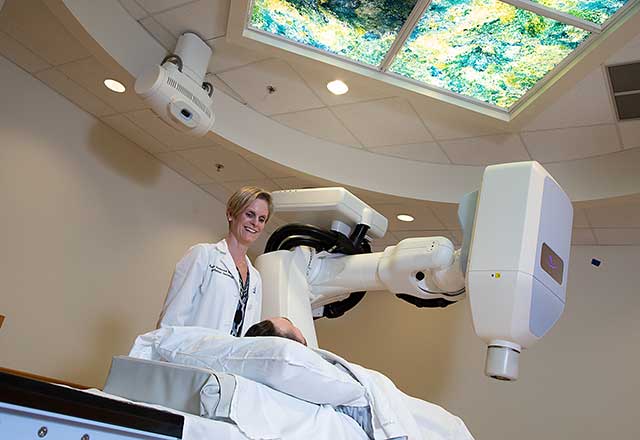Types of Treatments: External Beam Radiation

The experienced radiation oncology team specializes in treating a variety of cancers with a number of radiation therapy options, including proton therapy. All these therapies use high energy, penetrating waves or particles to destroy cancer cells or keep them from reproducing. Your medical team will determine the most effective options for you.
External beam radiation
External beam radiation delivers a beam of high energy X-rays to a patient’s tumor site to destroy cancer cells. The technique gets its name from the fact that the beams come from an external source (a machine called a linear accelerator) and are aimed at the site of the tumor.
There are several types of external beam radiation used at Johns Hopkins. They include:
- Image-guided radiotherapy (IGRT) – This technique uses frequent imaging to display the cancer site, allowing experts to provide highly precise and accurate delivery of the radiation. The radiation oncologist can create and view images of the tumor site before and during the time radiation is delivered. IGRT is particularly helpful for cancer sites in parts of the body that move (such as the lungs) or sites near major organs and tissues that should not receive radiation (such as the heart or kidneys).
- Intensity-modulated radiation therapy (IMRT) -- This radiation technology uses computer-controlled radiation beams in conjunction with three-dimensional computed tomography images of the tumor site and surrounding areas. IMRT delivers targeted radiation doses to the tumor site, patterned to match the shape of the tumor through modulating the intensity of the radiation beams. This means the tumor site receives the high doses needed to destroy cancer cells while sparing surrounding organs and tissue.
- 3D Conformal Radiation Therapy – For this technique, imaging scans are used to create a three-dimensional model of the exact shape and size of the tumor. Then multiple radiation beams are aimed at the tumor shape, sparing nearby healthy tissue.
- TomoTherapy – This combines IMRT with computed tomography scans. Detailed, three-dimensional maps of a tumor’s size and location are created, then the machine delivers small beamlets of radiation from various angles, providing exceptional accuracy when targeting tumors.
- Volumetric Modulated Arc Therapy (VMAT) – Single or multiple radiation beams sweep around the patient, greatly reducing treatment time. Three-dimensional imaging technology aids in the precision of radiation delivery, giving doctors the ability to visualize the tumor at the time of treatment.
-
Stereotactic Body Radiation Therapy (SBRT) - This treatment administers very high doses of radiation using several beams of different intensities, and aimed at different angles to target the tumor. The therapy can be given as a single dose or up to several doses.
 Dr. Kristin Redmond with CyberKnife patient.
Dr. Kristin Redmond with CyberKnife patient.- CyberKnife, a type of SBRT, uses a robotic arm to deliver radiation in different ways and at different angles.
- Active Breathing Coordinator - Active Breathing Coordinator™ (ABC) is advanced technology that allows radiation treatment to be given only during the most favorable phase of the respiratory cycle.
The goal of any radiation treatment is to precisely target tumors and/or regions at risk with the correct, most effective dose while limiting radiation to surrounding healthy tissue and organs. This can be challenging since many tumors in the chest and abdomen are moving targets—shifting up and down as one breathes. ABC uses a computer-controlled device that looks like a snorkel to digitally monitor respiratory movement and ensure delivery of radiation only at the optimal phase of respiration.
Your treatment may couple ABC with radiation therapy for more precise treatment. ABC can be used with many types of radiation therapy.
